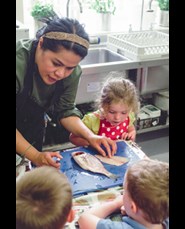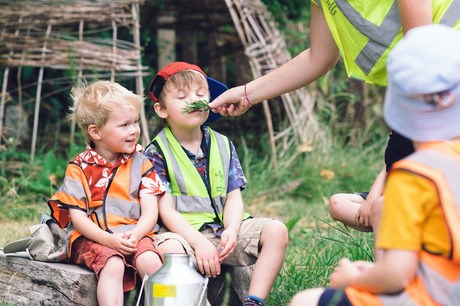Nursery Food: Cooking with children - Just for starters...
Mary Llewellin
Monday, October 19, 2015
Letting children get stuck into the cooking process, and linked activities, has many benefits. Snapdragons' Mary Llewellin explains

W?hat was the first thing you ever cooked? I remember sitting outside in the summer shelling fresh peas with my brothers and eating most of them before they got to the saucepan, so I am not sure that counts as cooking. The BBC’s Good Food team put the question to some of television’s most famous chefs and the answers included anchovies, bananas roasted on volcanic rocks and pancakes in an exploding Pyrex dish. Tom Kerridge, whose gastropub The Hand & Flowers was the first pub ever to win two Michelin stars, confessed that his debut dish was a Pot Noodle, so there is hope for us all.
When remembering their early experiments in the kitchen, the chefs nearly all described not just the dish, but the surroundings, the people they were with and the pride in their achievement. So it is not just the end product that is important but the whole process.
Cooking is a great way to develop a wide range of skills: as children count out eggs, weigh flour, choose ingredients to create new flavour combinations, and knead dough and see how the yeast makes it rise, they are extending their maths, science, communication, creativity and motor skills and learning about healthy food choices. And of course, it is great fun and a wonderfully social activity.
At Snapdragons, we have really concentrated on extending the children’s cooking beyond fairy cakes. We want them to be involved in preparing ‘real’ food as much as possible and to make the connection between the raw ingredients growing in our gardens and fields and the food on their plates. Growing vegetables in the nursery garden, foraging for blackberries, visiting farms and choosing ingredients in the local supermarket are all part of the fun of preparing food. Raquel Kneeves, our chef at Snapdragons Keynsham, loves the children to come into her kitchen when she has got some new ingredients or an interesting process to learn about. For Chinese New Year she taught the children to make fortune cookies, which bake in seconds and have to be moulded while warm, so the cooker needed to be close at hand. She has shown the children how to fillet a fish and let them help her to mince beef for homemade burgers.
Raquel Kneeves, our chef at Snapdragons Keynsham, loves the children to come into her kitchen when she has got some new ingredients or an interesting process to learn about. For Chinese New Year she taught the children to make fortune cookies, which bake in seconds and have to be moulded while warm, so the cooker needed to be close at hand. She has shown the children how to fillet a fish and let them help her to mince beef for homemade burgers.
Of course, these processes involve sharp knives and dangerous equipment, so are really more of a spectator sport, but Raquel is passionate that the children should learn about the raw ingredients that make up their meals and the children are fascinated.
TOOLS FOR THE JOB
So what are the skills and the utensils that we can safely introduce? The first thing is to make sure that children have tables at the right height. Cooking in an adult kitchen often involves a precarious balancing act as children stand on steps or chairs and wobble dangerously as they work.
When we designed the interior of our latest nursery in Bristol we installed a children’s kitchen in a room adjoining the pre-school. This room has a low-level work surface, sink and cupboards with enough space and equipment for groups of about four children to cook together and wash up afterwards. There is also a cooker so that the children can see their creations going into the oven and watch as they come out transformed. Keeping away from the hot oven and watching an adult use oven gloves to handle steaming dishes is all part of the learning process, and the children know that they never go into the kitchen without a grown-up.
We have sets of utensils so that the children can cook alongside each other in companionship and with pride in their own achievements. As well as the usual mixing bowls, sieves, spoons and rolling pins, we allow the children to use round-tipped serrated knives, graters and vegetable peelers for preparing medium to soft fruit and vegetables. It is true that children can cut themselves with these but, as long as there is adequate instruction and supervision, we feel that is a managed risk.
On the whole, we believe that it is best for children to use adult-sized utensils. Often, children’s versions are not up to the job and there is nothing more discouraging than using a knife that won’t cut or a plastic spoon that bends instead of beating.
We have, though, discovered an ingenious dispenser with a tap that helps children to measure flour without too much mess. Learning about food hygiene is all part of cooking, too, and we have sets of aprons and chefs’ hats to keep clothes clean and hair out of the food – they look really sweet.
Of course, you don’t need a special kitchen or utensils. Really, it is more important to get stuck in and involve the children in as many different processes as you can: spreading, kneading, rolling, cracking, mashing, crushing, cutting, sprinkling, sieving, shaping – such a lot of new skills and new words, too.
SUPPORTED WITH ROLE PLAY
A well-thought-out home corner helps children re-enact cooking experiences, and we have home corners in all our rooms. Some simple low-level units are the starting blocks – then try to look with a child’s eye at the provision. Can you arrange your store cupboard, bake a cake or invite your friends to tea if you only have one plate and the oven is full of toy cars?
We try to make sure that there are sets of saucepans, crockery and cutlery, that we keep stocking up on empty food packets and that everything goes back to its proper home at the end of sessions. We love Community Playthings’ almost indestructible home corner equipment and there are some great supporting articles on its website.
MUD PIES, MAGIC POTIONS
The cooking doesn’t stop when we get outside, either. Give a child a buc-
ket and a stick and it won’t be long before they are making a muddy hot chocolate or a petal potion. We have set up mud kitchens in our nursery gardens: we started with log tables and upturned wooden crates, but our maintenance man has got the bit between his teeth now and is producing ever more accomplished kitchen workstations with sinks and shelves.
These are stocked with saucepans donated by staff and parents, and the children love mixing, chopping and producing concoctions of mud, sand, grass and flowers, all the time using their new culinary vocabulary.
GOING WILD

Our leader of outdoor learning, Tim Graham, is a great naturalist and lover of foraging, and he often includes a foodie element to his forest sessions with the children. Recently he and the children gathered elderberries and made elderberry cordial packed with vitamin C. Using a Kelly Kettle, the children have brewed mint and lemon verbena tea outside with leaves from the herb garden.
This is an area to be approached with extreme caution if you are not an expert. Tim has a firm set of rules, which the children repeat with him at the beginning of sessions, about not picking or eating things without checking with a grown-up. If you want to cook outside but don’t want to use wild food, you can still invest in a Kelly Kettle and bring out some hot chocolate instead of herbs, or try toasting bread over a small firepit.
READY STEADY COOK
- Find some great recipes for real cooking with children from Jamie Oliver, www.jamieoliver.com/recipes/kids-recipes/#U6iFEgbtDchUdVGB.97
- Home corners with Community Playthings,
- www.communityplaythings.co.uk/learning-library/articles/the-home-corner
- More about mud kitchens from outdoor play expert, Jan White, https://janwhitenaturalplay.wordpress.com/tag/mud-kitchens
- Brew up outside with a Kelly Kettle,
- www.kellykettle.com
- See the Kelly Kettle in action in Snapdragons’ forest article, http://downloads.snapdragonsnursery.com/magazine/2012/January2012.pdf
Mary Llewellin is operations manager for Snapdragons. Snapdragons Keynsham has the Food for Life Partnership Gold Catering Mark, is accredited by the Vegetarian Society and was winner of the Nursery World Nursery Food Award in 2012 and 2014. www.snapdragonsnursery.com







